The Hidden Meaning Behind Timesheet Management: What Your Logged Hours Really Reveal
Uncover team insights with timesheet management. Learn how timesheet data reveals productivity, burnout risks, and inefficiencies to optimize planning and foster a balanced work culture.
Timesheets often feel like a chore, a box to check for payroll or compliance. Most teams see them as administrative burdens rather than sources of insight. However, each logged hour holds more than a number; it reflects team behaviors, work habits, and organizational health. These entries reveal how work unfolds, where stress builds, and what drives success.
This article explores how timesheet management uncovers hidden patterns and offers practical ways to turn data into actions that boost productivity, balance workloads, and strengthen team dynamics. By looking beyond the numbers, managers can transform timesheets into tools for meaningful change.
Timesheet Management: More Than Time Tracking
Timesheet management goes beyond tracking hours for accountability. It serves as a diagnostic tool, showing how work happens in practice. A weekly timesheet highlights gaps between planned tasks and actual effort. This data reveals which projects overrun, where resources are stretched, and how priorities align with goals. Accurate time tracking pinpoints tasks that take longer than expected, signaling scoping issues or unclear requirements. By analyzing these patterns, leaders can allocate resources wisely and adjust plans proactively. Timesheet management bridges intention and reality, driving better decisions.
What Timesheet Management Reveals About Logged Hours (and What to Do About Them)
Timesheet data tells stories about team dynamics, inefficiencies, and opportunities. Each pattern points to a root cause and a chance to act. Below are seven symptoms, their causes, and actionable steps to address them.
Productivity Rhythms: When Your Team Works Best
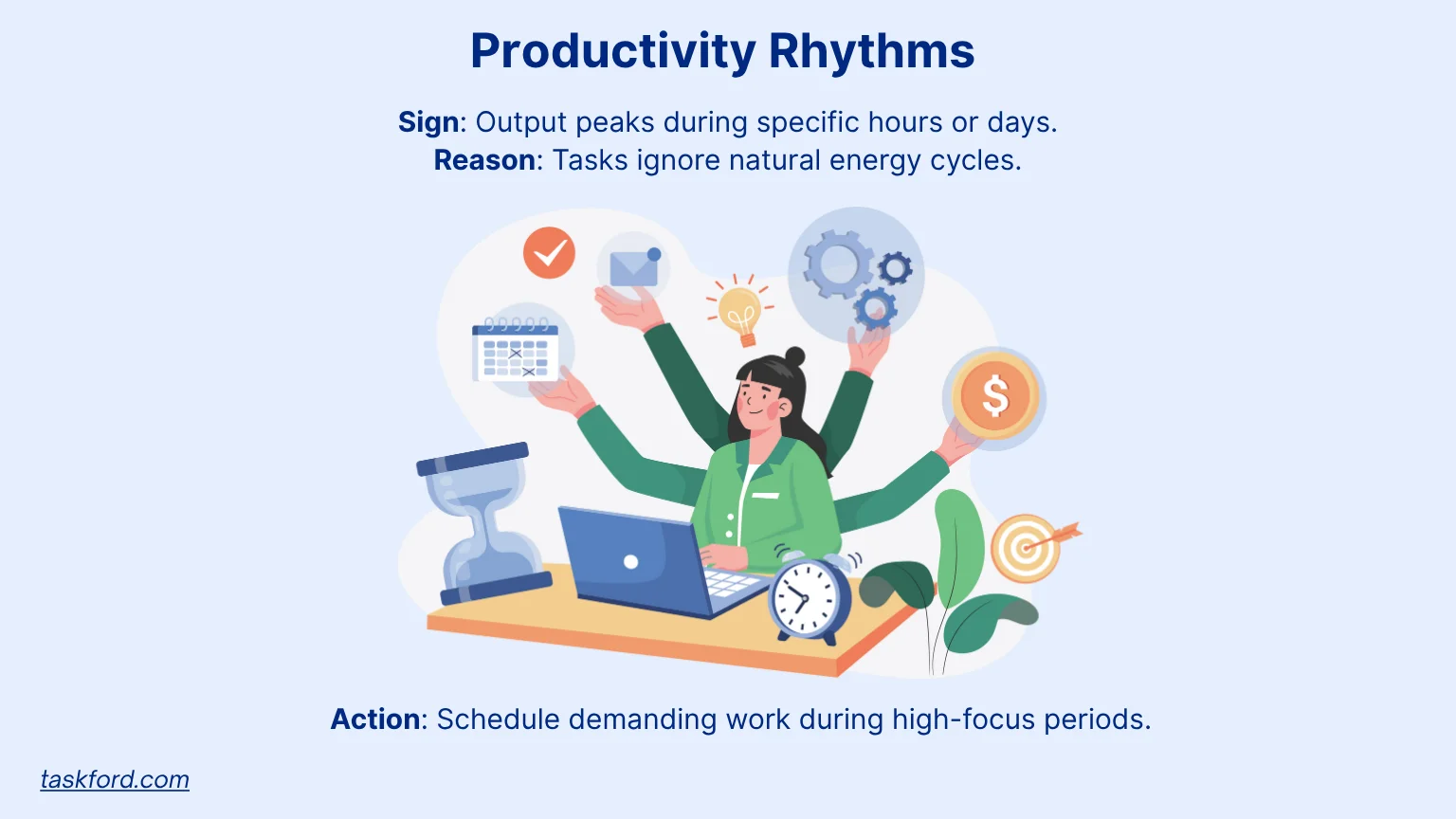
Symptom: Weekly timesheets show higher output or faster task completion during specific hours or days. Certain periods, such as mid-morning or early afternoon, consistently yield better results. This pattern appears across multiple team members or projects, indicating a trend.
Root Cause: Teams have natural productivity cycles influenced by energy levels, focus, and external distractions. Rigid schedules often ignore these rhythms, leading to misaligned task assignments. This misalignment wastes high-energy periods on low-value work, reducing overall efficiency.
Action:
- Analyze timesheet trends to identify peak productivity windows and align demanding tasks with those periods. Schedule complex tasks during high-energy periods to maximize output.
- Use project management software with timesheet tracking to visualize patterns. This helps align routine tasks with lower-energy times, optimizing team performance.
Workload Imbalances and Hidden Burnout Risks
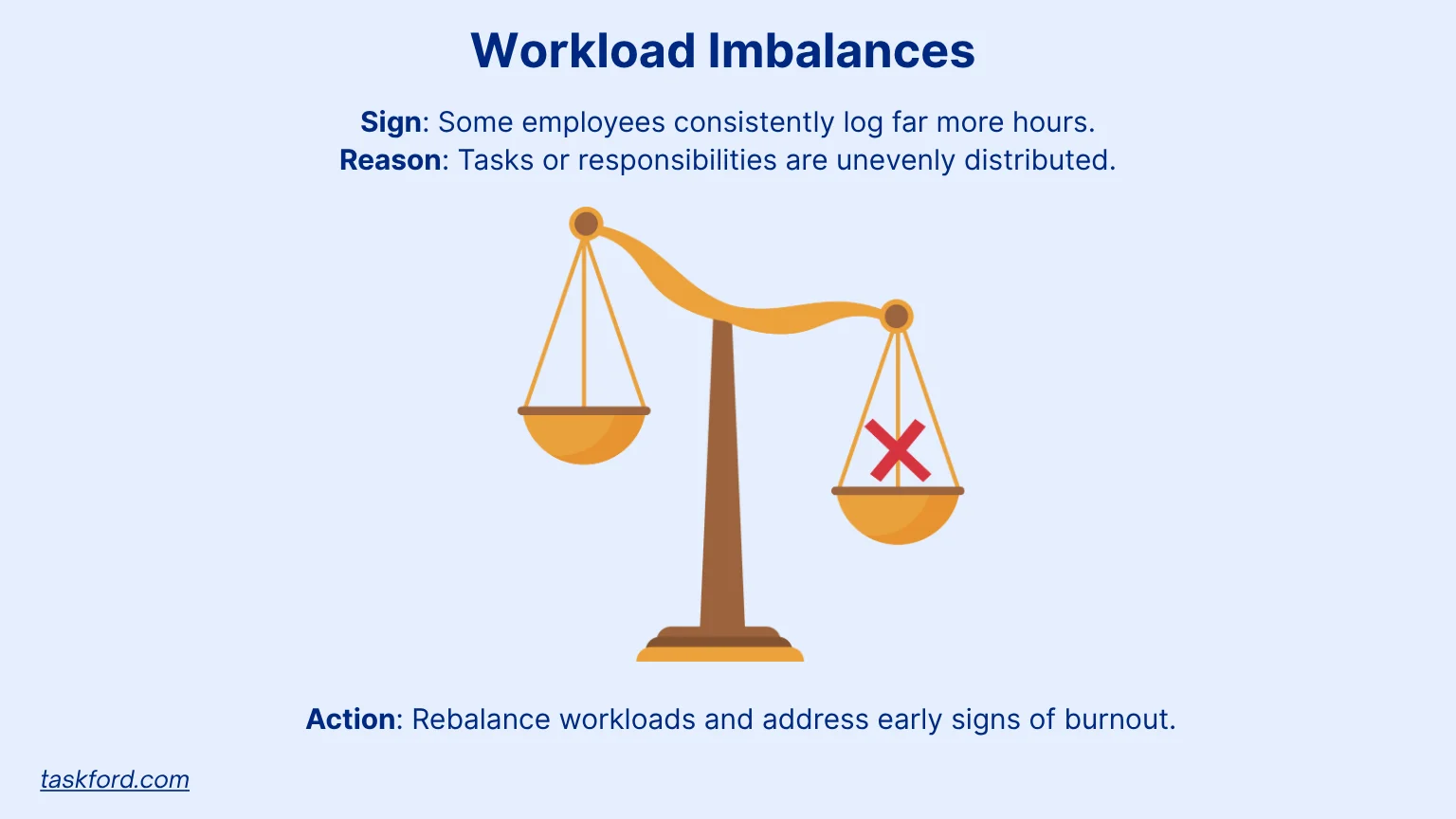
Symptom: Some team members log significantly more hours than others in similar roles or project phases. Disparities are evident in weekly timesheet reports, with certain individuals consistently overworking. These patterns persist across weeks, suggesting a systemic issue.
Root Cause: Uneven task distribution or hidden dependencies overburden specific team members, creating stress. This imbalance often stems from unclear role definitions or reliance on key individuals for critical tasks. If unaddressed, it risks burnout and reduced team morale.
Action:
- Review timesheet data to detect workload imbalances and redistribute tasks for fairness. Open discussions about workload can uncover hidden pressures and prevent resentment.
- Leverage timesheet software for small business to highlight disparities early. Have task automation or clarify roles to reduce strain on overworked team members.
(Learn more: How To Reduce Burnout On A Project)
Planning Gaps Between Expectation and Reality
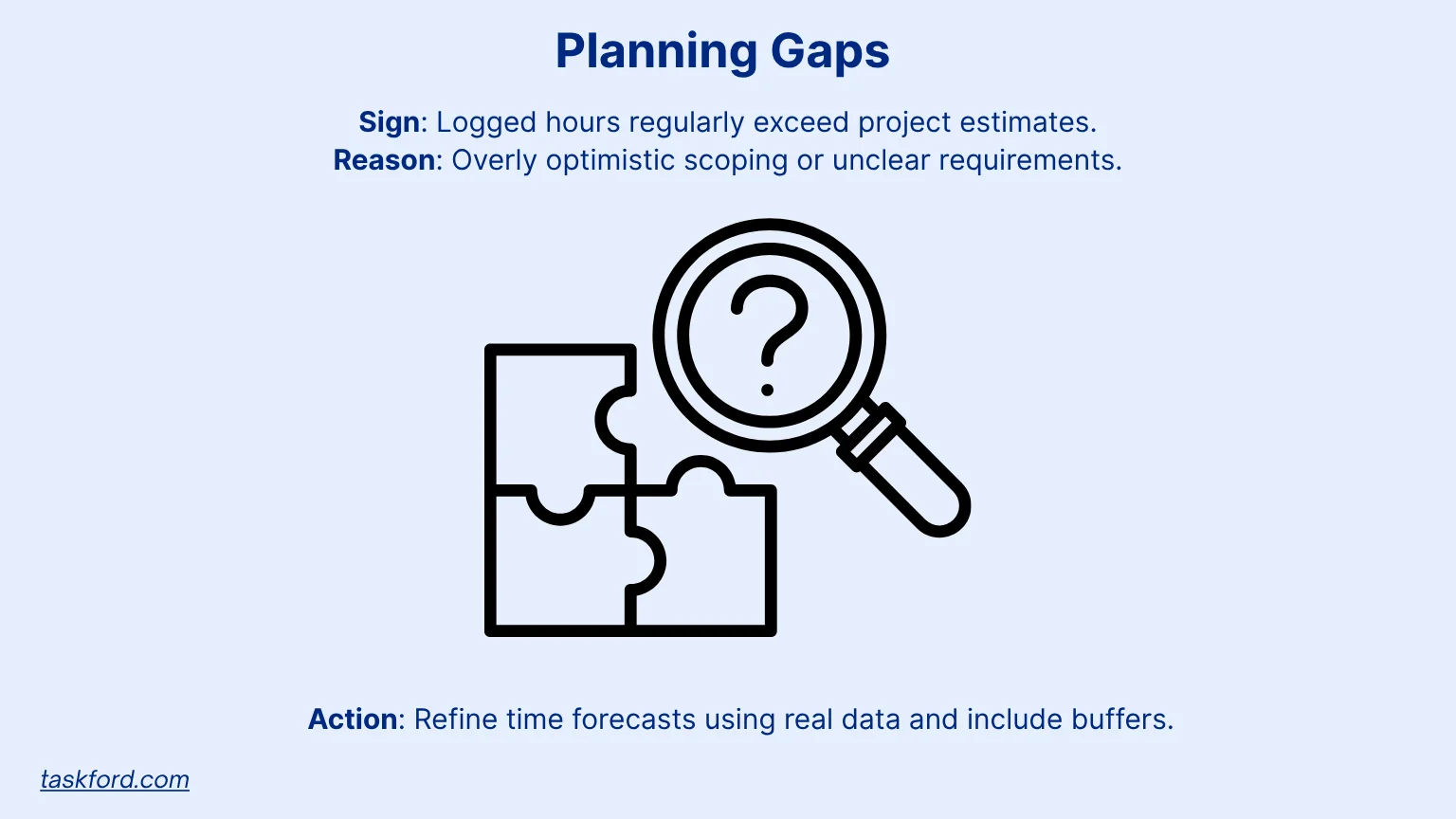
Symptom: Actual logged hours regularly exceed initial project estimates across multiple tasks. Projects consistently take longer than planned, as shown in timesheet data. This gap appears in both simple and complex tasks, indicating a recurring issue.
Root Cause: Overly optimistic scoping often underestimates task complexity or misses key steps. Unclear project requirements or lack of stakeholder alignment can further inflate time spent. These gaps erode trust in planning and strain team resources.
Action:
- Compare logged versus estimated hours to refine forecasting accuracy. Incorporate buffer time into future plans to account for unexpected delays.
- Use a timesheet printable report to visualize discrepancies. This helps teams discuss adjustments and update project templates for realistic planning.
Collaboration Efficiency: The Time Cost of Teamwork
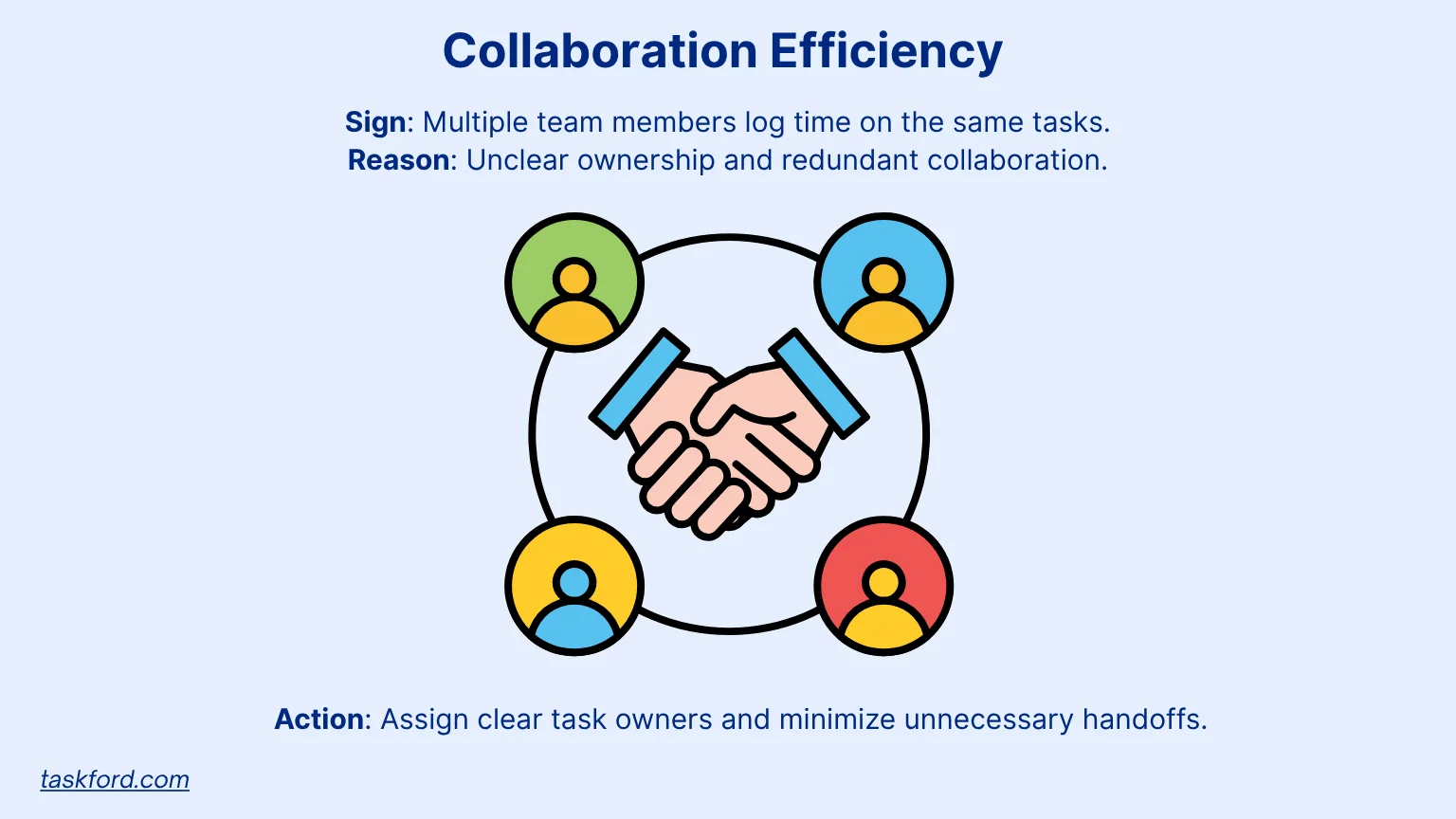
Symptom: Multiple team members log small time entries for the same task, creating fragmented effort. Projects show excessive contributor overlap in timesheet reports, slowing progress. This pattern repeats across collaborative tasks, indicating inefficiency.
Root Cause: Unclear task ownership leads to frequent handoffs and redundant approvals, bogging down workflows. Lack of defined roles causes team members to step on each other’s toes. Poor communication structures, like excessive meetings, exacerbate the issue.
Action:
- Define clear task owners to streamline workflows and minimize unnecessary handoffs. Asynchronous updates can replace redundant meetings to maintain project momentum.
- Use project management tools with time management capabilities to flag tasks with excessive contributors. This allows managers to simplify processes and enhance collaboration efficiency.
Task Value vs. Time Spent
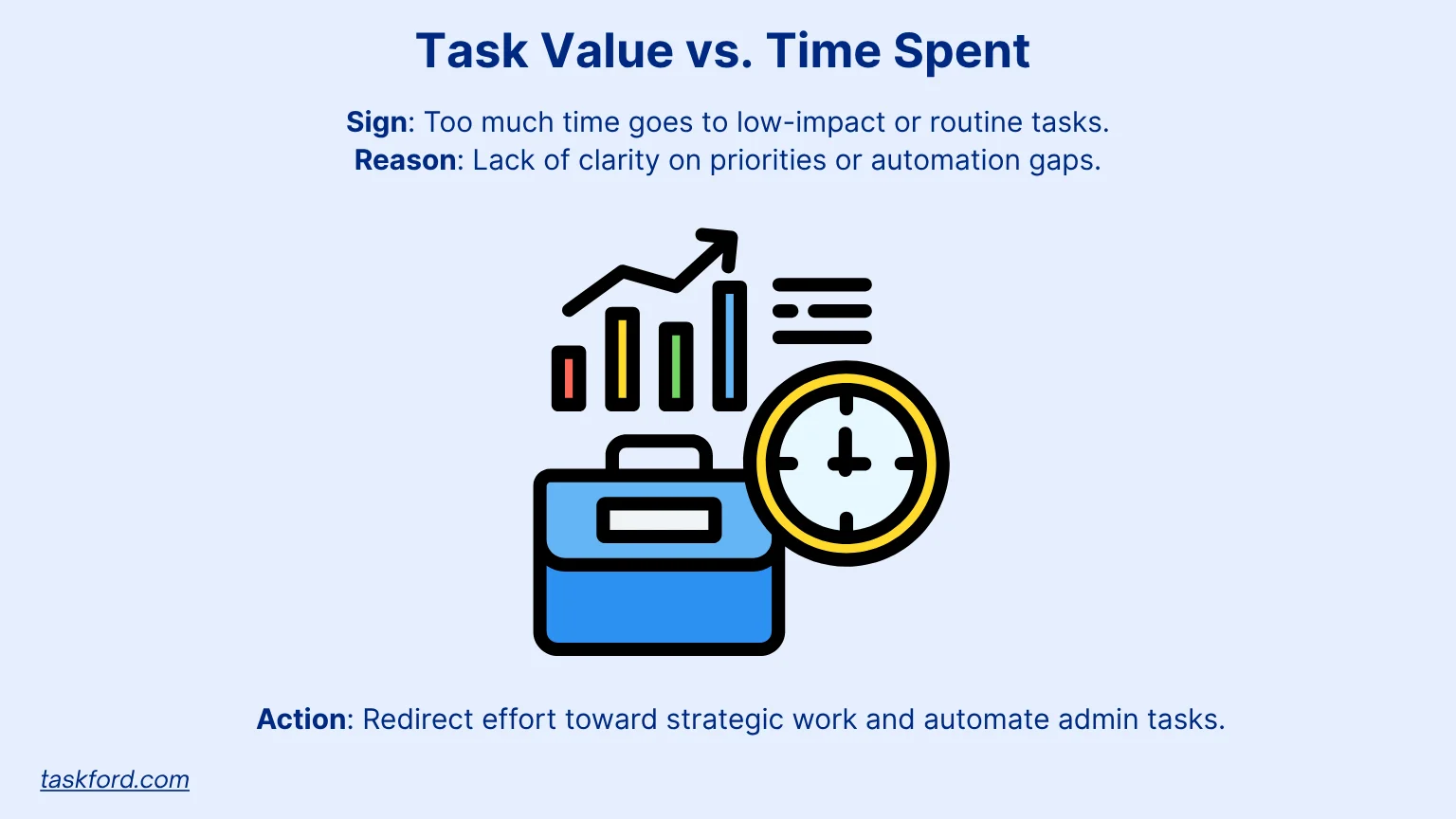
Symptom: A large share of logged hours is spent on administrative or maintenance tasks rather than strategic work. Timesheets show disproportionate time allocated to low-impact activities. This trend persists across team members, diluting overall productivity.
Root Cause: Effort is misdirected toward “busy work” due to unclear priorities or lack of automation. Teams may lack guidance on distinguishing high-value tasks from routine ones. This misalignment shifts focus away from organizational goals.
Action:
- Categorize tasks by strategic impact using timesheet data. Shift resources to high-priority work by delegating or automating low-value tasks.
- Generate reports with timesheet software for small business to highlight time allocation. This guides leaders to prioritize efforts that align with organizational goals.
Engagement and Focus Indicators
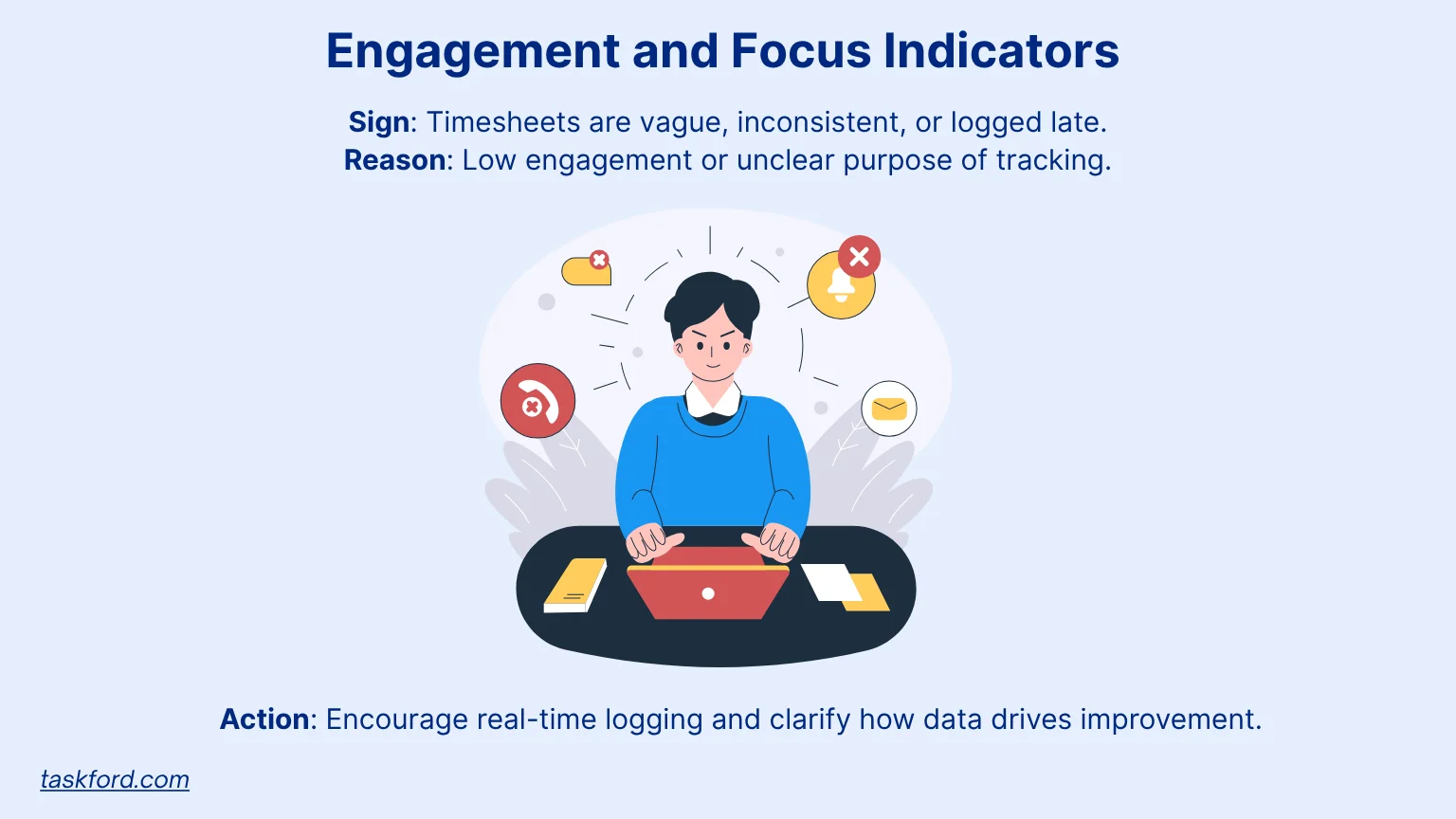
Symptom: Timesheets show irregular or last-minute entries, often submitted at the end of the week. Tracking behavior appears inconsistent, with some entries vague or incomplete. This pattern suggests employees are not prioritizing time management.
Root Cause: Team members may be distracted, multitasking excessively, or disengaged from the time-tracking process. This can stem from a lack of understanding about the value of timesheets. It may also reflect broader issues with focus or workload clarity.
Action:
- Promote time tracking to improve accuracy and reduce rushed entries. Frame timesheets as tools for insight, not surveillance, to increase team buy-in.
- Implement weekly timesheet reminders to encourage consistent logging. Discuss workload openly to address distractions and clarify priorities, fostering better engagement.
Organizational Health Signals
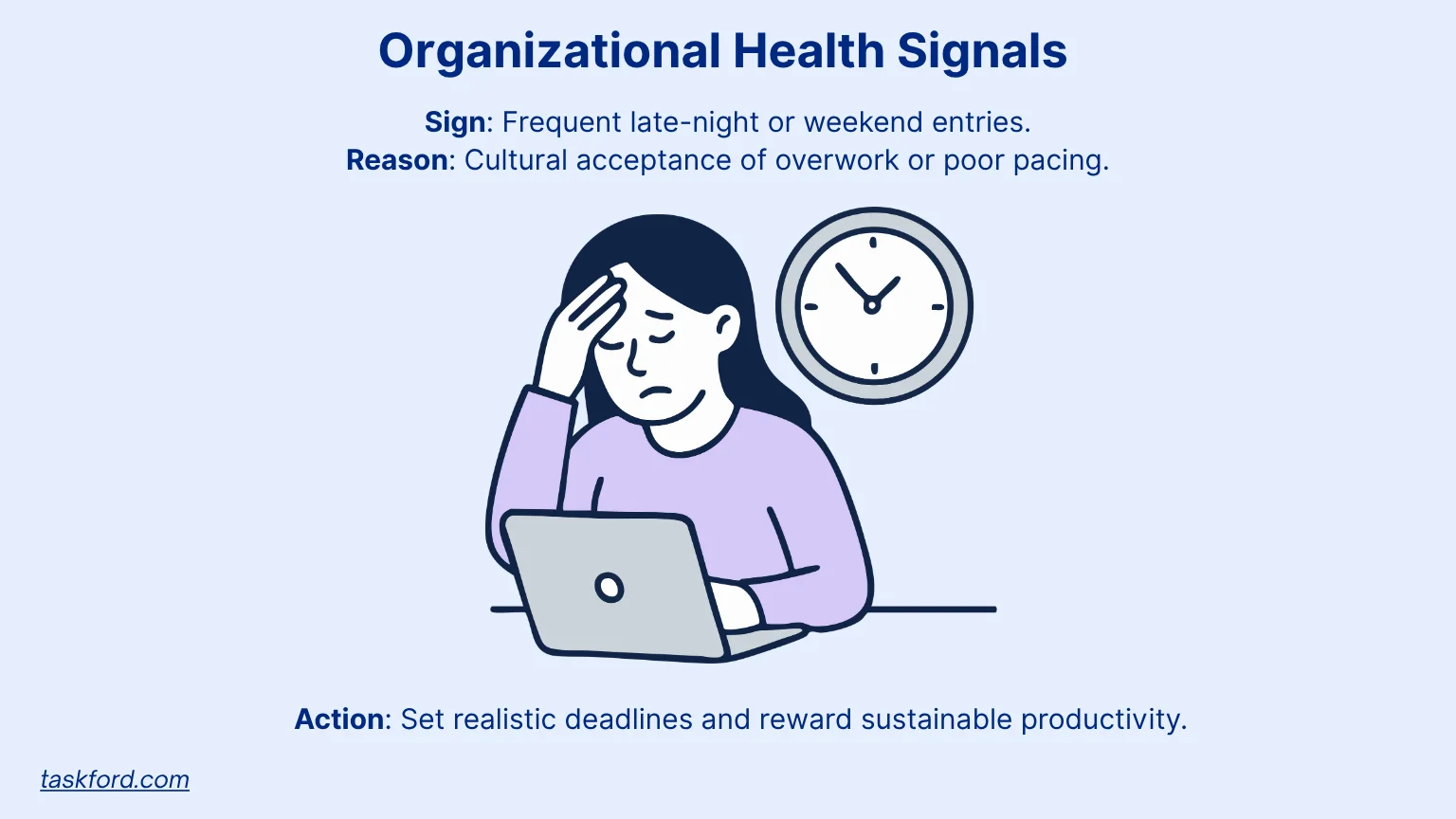
Symptom: Timesheets show frequent late-night or end-of-week logging across the team. Overtime patterns appear regularly, with hours logged outside standard work times. These trends persist over weeks, signaling a deeper issue.
Root Cause: Cultural issues, such as unrealistic deadlines or a “heroic overtime” mindset, drive unhealthy work habits. Poor project pacing forces employees to rush or overwork to meet goals. This can erode morale and lead to long-term burnout.
Action:
- Use timesheet data to identify overtime trends and address root causes like understaffing or tight deadlines. Promote sustainable project pacing to reduce reliance on overtime.
- Measure success by outcomes, not hours worked, to shift team culture. Model balanced work habits to encourage healthier practices across the organization.
Turning Logged Hours into Insight With Timesheet Management
Timesheet management thrives when data is analyzed at scale to uncover trends and risks. By examining patterns across weeks, roles, or project types, managers can identify inefficiencies and opportunities early. Key metrics to monitor include:
- Accuracy Rate: This measures the gap between planned and logged time. Large gaps indicate issues with scoping or unrealistic expectations, which can derail projects. Regular analysis helps teams adjust estimates and improve planning precision. Reviewing these gaps fosters accountability and sharper forecasting.
- Utilization Rate: This tracks the percentage of time spent on productive work versus administrative tasks. Low rates suggest inefficiencies or misaligned priorities that need realignment. Monitoring utilization helps ensure resources focus on high-value activities. It also guides decisions on process improvements or automation.
- Focus Ratio: This compares uninterrupted work to fragmented effort. High fragmentation signals excessive meetings or multitasking, reducing efficiency. Addressing this can lead to streamlined workflows and better focus. Tracking focus ratios helps teams prioritize deep work and minimize distractions.
These metrics allow managers to spot risks like overcommitment or low morale before they escalate. For instance, a low focus ratio might prompt a review of meeting schedules, while a poor accuracy rate suggests better scoping is needed. Time tracking software automates these analyses, providing visual dashboards to track trends and enable swift action.
Building a Culture of Meaningful Time Tracking
Effective timesheet management relies on trust and transparency to ensure accurate data. When employees understand the purpose of time tracking, they engage more fully, improving data quality. Managers can foster a positive culture by:
- Sharing Insights: Present aggregated timesheet data during team meetings to demonstrate its value. Show how it informs resource allocation, process improvements, or workload balancing. This transparency helps employees see timesheets as tools for team success, not just compliance. It also builds trust in the process.
- Coaching, Not Controlling: Use data to guide discussions about workload and priorities, not to micromanage. This approach builds trust and encourages honest, accurate logging. Employees feel supported when data is used to improve their work environment. It fosters a collaborative atmosphere.
- Rewarding Accuracy: Recognize team members who log time consistently and accurately. Emphasize that reliable data drives better decisions, not punishment for imperfect hours. This positive reinforcement motivates teams to treat timesheet management as a shared responsibility. It strengthens team accountability and engagement.
A report shared during reviews can make insights tangible, showing teams how their data shapes outcomes. When employees view timesheets as tools for support, they log more consistently, enhancing data quality. This creates a cycle of better insights and stronger team performance. Sharing effective time management strategies can also help employees improve
The Role of Tools Like TaskFord in Timesheet Management
Timesheet management doesn't only go with Microsoft Excel, it also thrives with the right tools. TaskFord, a comprehensive project management and resource planning platform enhances timesheet management by its following abilities:
- Timelog Board: TaskFord provides a clear board of logged time by task or assignee. These visuals help managers quickly identify productivity peaks or workload imbalances. This clarity enables faster, data-driven decisions to optimize team performance.
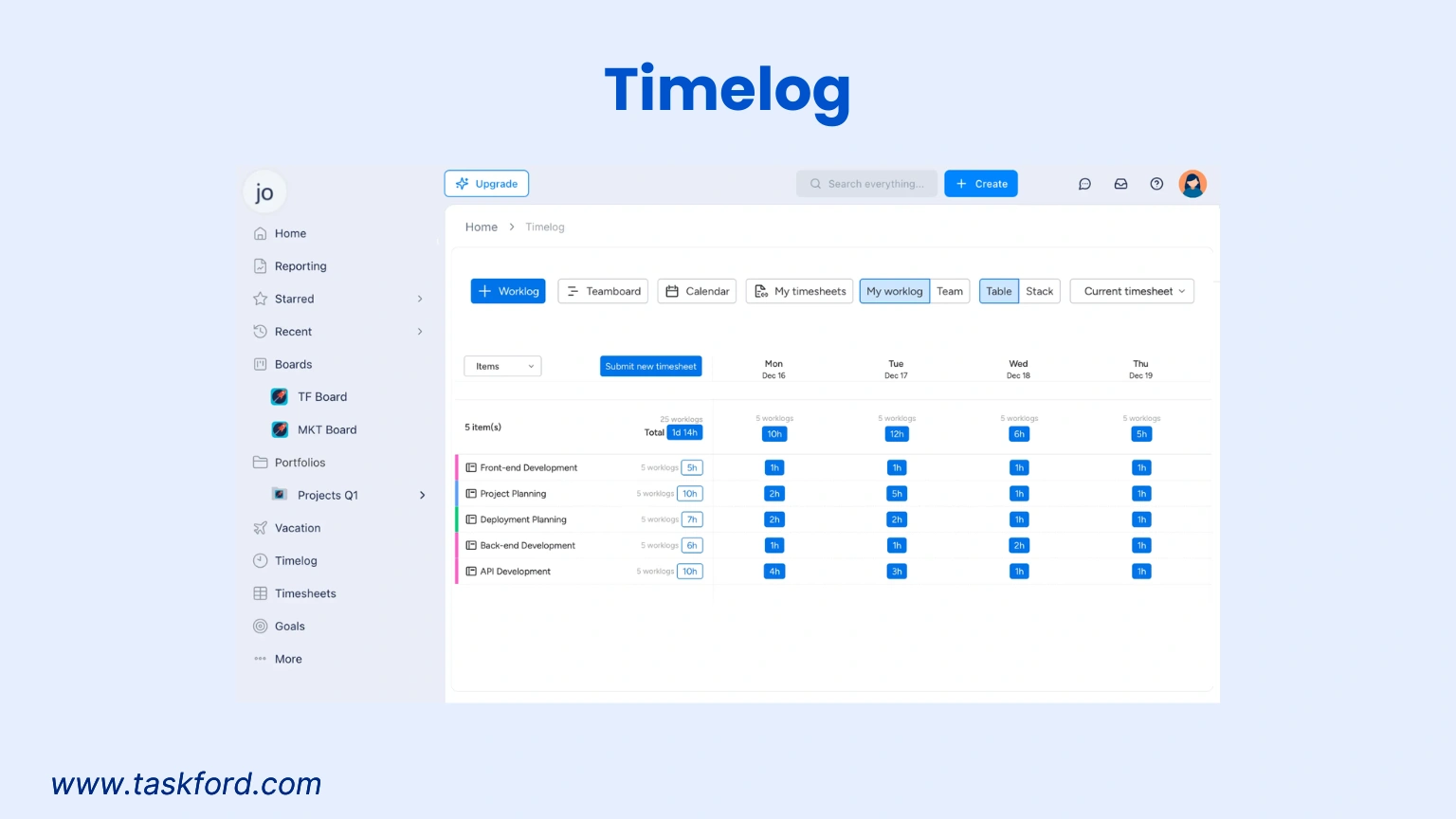
- Comparative Reports: Managers can compare actual versus planned time to refine estimates. These reports highlight discrepancies, improving forecasting and project planning accuracy. TaskFord’s intuitive interface makes it easy to act on these insights promptly.
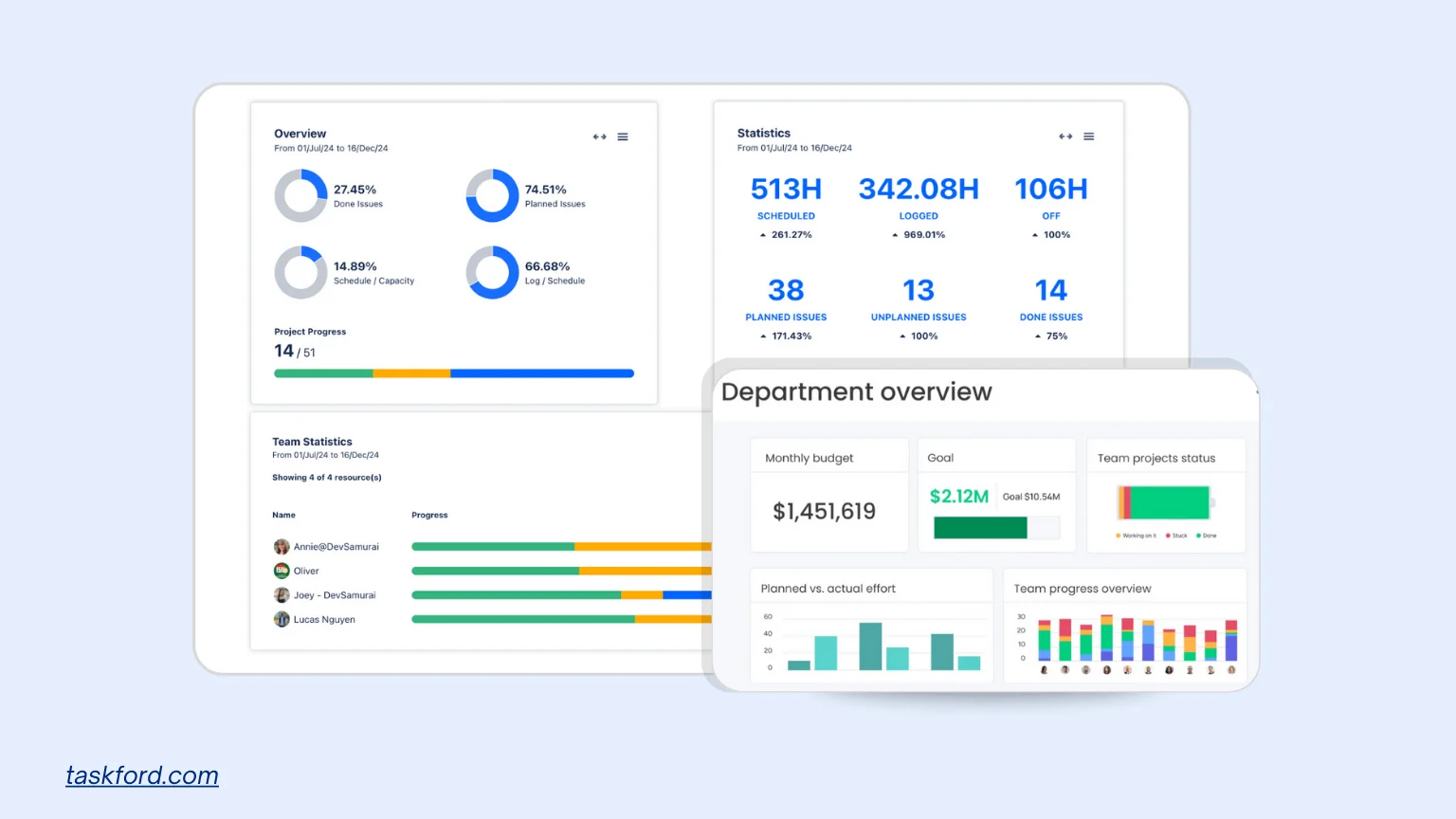
- Workload Management: TaskFord shows overworked team members before issues escalate. This early warning system allows leaders to intervene proactively, preventing burnout or delays. It ensures resources are allocated effectively to keep projects on track.
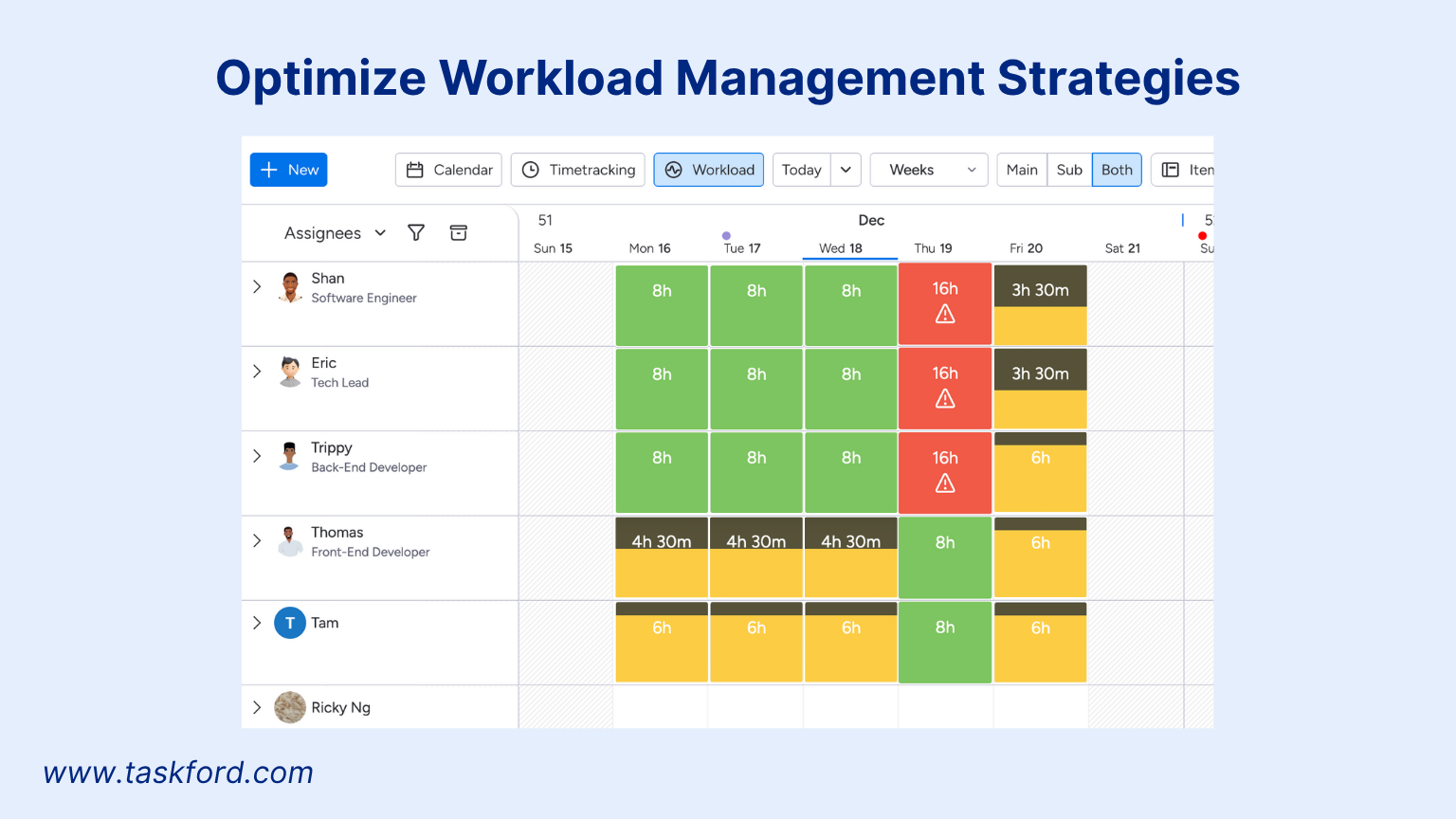
Unlike basic tools, TaskFord empowers leaders to understand team dynamics without micromanaging. It’s ideal for small businesses seeking timesheet software for small business or larger teams needing project management timesheet software. TaskFord transforms timesheets into a strategic advantage, driving smarter decisions.
Conclusion
Timesheets are more than records of hours worked. They reflect how teams operate, prioritize, and cope with challenges. From spotting burnout risks to refining project plans, timesheet management uncovers the pulse of an organization. By analyzing metrics like accuracy, utilization, and focus, leaders can address inefficiencies and foster healthier work habits.
Tools like TaskFord amplify these insights, making data actionable and intuitive. The true power of timesheet management lies not in tracking time, but in understanding it. By reading between the hours, managers can build teams that are productive, balanced, and aligned with their goals.
Making work simpler,
smarter, and more connected
Join our waitlist and be notified first.

Subscribe for Expert Tips
Unlock expert insights and stay ahead with TaskFord. Sign up now to receive valuable tips, strategies, and updates directly in your inbox.




